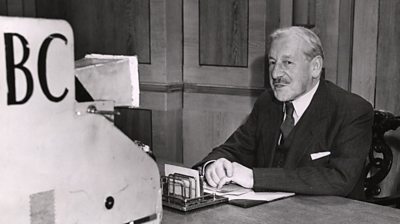The first Party Election Broadcasts were made on ����ý radio during the 1924 general election campaign. The three main party leaders each delivered broadcasts lasting twenty minutes.
In 1947 the Committee on Party Political Broadcasts was established to regulate the number of broadcasting allocations to each party. The committee comprised representatives of the three main political parties together with the ����ý.
Following the advent of the ����ý television service, the first television Party Election Broadcasts were shown during the 1951 general election campaign.

In these early years of television PEBs, broadcasts of around fifteen minutes were the norm.
In 1955, commercial television began broadcasting and the Independent Broadcasting Authority joined the ����ý in offering airtime to political parties. ITV transmitted its first PPBs in 1956.
Today, broadcasts are limited to no more than five minutes with political parties often preferring broadcasts as short as two and a half minutes.
Apart from party election broadcasts, which take place during election campaigns, party political broadcasts are offered in Britain on a seasonal basis: autumn – usually at party conference time - winter and spring. The largest parties in Northern Ireland are offered a broadcast each year. Since the advent of cameras in the Commons and the Lords, there are no longer Budget broadcasts or PPBs to mark the Opening of Parliament.
There Now Follows… the centenary of Party Election Broadcasting
Professor Dominic Wring of Loughborough University looks back at one hundred years of political broadcasts
Party Election Broadcasting is almost as old as British democracy. When the 1918 Representation of the People Act trebled the size of the electorate it enabled most Britons including some women to vote for the first time in that year’s General Election. Although the ����ý was launched two months before the subsequent election of 1922 the broadcaster had no part in the ensuing campaign. But it was not long before politicians began exploring how radio might play a useful role in helping them appeal to a now significantly enlarged electorate. From this the PEB - the now familiar Party Election Broadcast - was borne.
The task of communicating to a mass audience of voters presented politicians with a major challenge. Parties recognised that while traditional forms of campaigning such as canvassing, leafleting and meetings were still valuable, broadcasting offered a more practical way of reaching millions of citizens during the short few weeks of an election campaign. What in autumn 1924 with Broadcasts by each of the three major party leaders all of whom had served as Prime Minister.
Going live: in the beginning
While a great deal has obviously changed over the last hundred years, featured formats and content that are familiar to this genre. For instance, the Conservative Broadcast devoted to Cabinet minister Laura Trott delivering a speech from a podium resembles the live address made by the then Labour Prime Minister Ramsay MacDonald in the first ever PEB. Writing in the historian John Antcliffe explained how radio listeners struggled to hear MacDonald because he was talking from the acoustically challenging interior of Glasgow’s huge City Hall. Four days later a similar fate befell Herbert Asquith in the debut Liberal Broadcast. Speaking live from his Scottish constituency of Paisley, the ex-premier was interrupted mid flow by the arrival of leading supporter Lady Bonham Carter whom he proceeded to greet by leading a round of applause.
The Conservatives, the only other party to be granted airtime during the 1924 election, provided their audience with an altogether different listening experience. In his Broadcast Stanley Baldwin outlined his vision for the country from the quiet confines of the ����ý’s original 2LO studios in central London’s Strand. Although radio was still in its infancy, the Tory leader recognised (admittedly with guidance from his acquaintance Lord Reith, the then ����ý Managing Director, who was present as the speech went out) that the most effective means of communicating via this novel medium was to address listeners as though he were talking with an individual person.
Stanley Baldwin’s speech created a sense of intimacy absent from either of his rivals’ Broadcasts, although his talk was hardly a significant factor in his party’s victory at the polls two weeks later given radio was still very much in its infancy. But Baldwin had demonstrated an effective way of using the new medium that US President Franklin Roosevelt would later emulate in his now venerated with – or rather to - the American people.
Onto the small screen: the personal is political
The first ever televised PEB aired in 1951, almost 27 years to the day after their launch on radio. It took the form of the classic ‘talking head’ format in which the ageing former Liberal leader Lord Samuel tried and failed to get to the end of his live talk. Broadcasts of this kind dominated by single politicians were common but these have become increasingly personal in their content over the last forty years. A prime example of this is the 1987 biopic of Labour leader Neil ‘Kinnock the Movie’ (and one that Joe Biden, a prospective US presidential candidate, was accused of plagiarising in a row that helped end his 1988 bid for the White House). In the following election of 1992 Kinnock’s opponent John Major featured in ‘The Journey’, a PEB about the Tory Prime Minister’s humble beginnings and formative experiences.
The turn to a markedly more personal style of Broadcast has been encouraged by the growing influence of dedicated campaign professionals. Over the last few decades British politicians have taken advice from leading American political consultants such as Joseph Napolitan, who first came to prominence having helped John F. Kennedy become US President. Napolitan began , a period during which the party’s increasingly presidential approach to campaigning culminated in Kinnock the Movie. The consultant had gained insights into the benefits of biographical style campaign films having previously advised US Vice President Hubert Humphrey, the Democrat who nearly prevented Richard Nixon becoming President. Humphrey’s 1968 election advert, , featured the candidate talking about his personal life and in particular his disabled granddaughter who also appeared on screen.
The 2024 PEB featuring Ed and his son John Davey follows in the tradition of What Manner of Man. The Liberal Democrat leader’s very personal testimony about his own child facing families caring for loved ones with special needs. The Daveys’ experience demonstrated the continuing value of PEBs in enabling parties to make their case to the public. The mention of Richard Nixon is also a reminder that, as the then US Republican vice-presidential nominee, in response to a scandal. Nixon succeeded in saving his political career with a bravura performance in which he talked about his family and namechecked their new black and white coloured cocker spaniel whose name defined what became known as the ‘Checkers speech’.
Pets can make politicians appear more relatable. A dog was noticeably present alongside owner Nigel Farage in a PEB in which he explained his reasons for returning to frontline politics following the announcement of the 2024 General Election. Sitting in the countryside near his home, the Reform UK leader was visibly more relaxed making the case for reducing immigration free from media interrogation. The film offered a contrast to the party’s opening and highly idiosyncratic Broadcast which was wholly devoted to one static campaign slogan. : ‘Your TV isn't broken, but Britain is. I hope you enjoy our Party Election Broadcast’.
The popular touch: celebrity news
During the 2024 campaign Keir Starmer appeared in a PEB speaking about his parents in addition to his political beliefs. The on a walk through the Lake District, a place the MP revealed was a favourite family holiday destination when he was growing up. While both men’s names were captioned, the ex-footballer needed no further designation whereas the politician was identified as ‘Leader of the Labour Party’. Neville’s questioning prompted Starmer to outline his policies and credentials for becoming Prime Minister in another format that derives inspiration from the past. The celebrity interview was in fact adopted for the first ever on screen Conservative PEB in 1951 . Eden was regarded as a more effective television performer than his leader Winston Churchill, who really disliked appearing on the medium. And like Gary Neville before him, Mitchell’s role was to enable his co-host to get across his campaign priorities.
in 1951 featured another famous co-presenter, the renowned lawyer turned politician Hartley Shawcross, who appeared alongside fellow minister Christopher Mayhew. Their studio based ‘two heads are better than one’ approach has been routinely used in subsequent elections including by the Green Party co-leaders in 2024. The SNP adopted the format in their opening Broadcast in which Scottish First Minister John Swinney was joined by his deputy Kate Forbes to reassure voters that they were working well together as a newly formed team.
Keeping it real: target(ing) voters
Introducing Labour’s first ever PEB, Christopher Mayhew suggested viewers’ newspaper preferences would likely make them sceptical towards his party. The comments revealed an appreciation that the available audience was atypical of the wider electorate given television ownership was still restricted to those wealthy enough to purchase a set. In this way PEBs can be revealing about the kinds of voters who are being targeted. Labour’s 2024 launch PEB featured people belonging to a priority group, , who had previously favoured the Conservatives. Each of them explained why they were now supporting the party giving one of its six ‘steps for change’ as their reason. Captions revealed the voter’s occupational background and those participating varied in terms of their age, sex, and ethnicity. This emphasis on diversity is a now familiar feature of promotional appeals, although it is not new in this kind of campaigning.
In the first US ‘television election’ of 1952, the winning candidate appeared in which he responded to various queries from members of the public. Each questioner reflected the kind of voter – be they African American, older women, or younger adults among others - that strategists were most keen to cultivate. Target voters would similarly become increasingly recognisable in British campaigns. For instance, in the closely contested 1970 General Election, the Conservatives identified working-class women as a potentially receptive audience for their cost of living focused messaging. A PEB centring on Sylvia, a young mother who was representative of this group, featured her explaining her disillusionment with Labour and decision to vote differently to her husband.
Representatives of ordinary people, or at least the actors playing them, by the advertising agency Saatchi & Saatchi, members of whom . In the earlier film ‘defendants’ representing different kinds of target voter appeared in a fictional court to plead guilty to charges of having aspired to a better quality of life under Labour. Very similar sentiments informed a 2010 series of PEBs made for David Cameron’s Conservatives in which people discussed their reasons for turning to the party. One featured Lucy, a mother of young children, who could have been Sylvia’s daughter given her age as well as their similar political outlook.
One hundred years on from their introduction, the quintessentially British system of Party Election Broadcasting survives despite having been . But as the above testimony demonstrates, PEBs – in so many ways - take us back to our democratic future.
Further reading
-
 Dr Alban Webb from the University of Sussex looks back over the history of Party Political Broadcasts
Dr Alban Webb from the University of Sussex looks back over the history of Party Political Broadcasts

